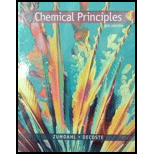
Consider 1.00 mole of an ideal gas that is expanded isothermally at 25°C from
Step 1: from
Step 2: from
Step 3: from
Calculate q, w,
Interpretation : The value of
Concept Introduction :
Work done can be calculated as follows:
The internal energy is sum of heat and work.
The change in entropy is calculated as follows:
Also, change in Gibbs free energy is related to change in enthalpy and entropy as follows:
w − work done
P − pressure
V − volume
n − number of moles
R − universal gas constant
T − temperature
ΔE − energy change
q − heat
ΔS − entropy change
ΔG − Gibbs free energy change
ΔH − enthalpy change
Answer to Problem 147CP
| q | w | ΔE | ΔS | ΔH | ΔG | |
| Step 1 | 1480 J | -1480 J | 0 | 7.56 J/K | 0 | -2250 J |
| Step 2 | 1240 J | -1240 J | 0 | 5.77 J/K | 0 | -1720 J |
| Step 3 | 1246 J | -1246 J | 0 | 5.81 J/K | 0 | -1730 J |
| Total | 3966 J | -3966 J | 0 | 19.14 J/K | 0 | -5700 J |
Explanation of Solution
Given information :
1.00 mole of an ideal gas is isothermally expanded at 25 0C as follows.
Step 1:
Step 2:
Step 3:
Step 1:
Step 2:
Step 3:
| q | w | ΔE | ΔS | ΔH | ΔG | |
| Step 1 | 1480 J | -1480 J | 0 | 7.56 J/K | 0 | -2250 J |
| Step 2 | 1240 J | -1240 J | 0 | 5.77 J/K | 0 | -1720 J |
| Step 3 | 1246 J | -1246 J | 0 | 5.81 J/K | 0 | -1730 J |
| Total | 3966 J | -3966 J | 0 | 19.14 J/K | 0 | -5700 J |
Thus,
| q | w | ΔE | ΔS | ΔH | ΔG | |
| Step 1 | 1480 J | -1480 J | 0 | 7.56 J/K | 0 | -2250 J |
| Step 2 | 1240 J | -1240 J | 0 | 5.77 J/K | 0 | -1720 J |
| Step 3 | 1246 J | -1246 J | 0 | 5.81 J/K | 0 | -1730 J |
| Total | 3966 J | -3966 J | 0 | 19.14 J/K | 0 | -5700 J |
Want to see more full solutions like this?
Chapter 10 Solutions
CHEM.PRINC.W/OWL2+REBATE+2 SUPPL.>IP<
- The formation of aluminum oxide from its elements is highly exothermic. If 2.70 g Al metal is burned in pure O2 to give A12O3, calculate how much thermal energy is evolved in the process (at constant pressure).arrow_forward2. In which of the following reactions is there a significant transfer of energy as work from the system to the surroundings? This occurs if there is a change in the number of moles of gases. C(s) + O2(g) → CO2(g) CH4(g) + 2 O2(g) → CO2g) + 2 H2O(g) 2 C(s) + O2(g) → 2 CO(g) 2 Mg(s) + O2(g) → 2 MgO(s)arrow_forwardExplain inyour own words why work done by the system is defined as the negative of pV, not positive pV.arrow_forward
- What are the two ways that a final chemical state of a system can be more probable than its initial state?arrow_forwardWhen vapors from hydrochloric acid and aqueous ammonia come in contact, they react, producing a white cloud of solid NH4C1 (Figure 18.9). HCI(g) + NH3(g) NH4Cl(s) Defining the reactants and products as the system under study: (a) Predict whether S(system), S(surroundings), S(universe), rH, and rG (at 298 K) are greater than zero, equal to zero, or less than zero; and explain your prediction. Verify your predictions by calculating values for each of these quantities. (b) Calculate the value of Kp for this reaction at 298 K.arrow_forwardThe standard enthalpy of formation of H2O(l) at 298 K is 285.8 kJ/mol. Calculate the change in internal energy for the following process at 298 K and 1 atm: H2O(l)H2(g)+12O2(g)E=? (Hint: Using the ideal gas equation, derive an expression for work in terms of n, R, and T.)arrow_forward
- A volume of 1.50 L of argon gas is confined in a cylinder with a movable piston under a constant pressure of 1.22 105 Pa. When 1.25 kJ of energy in the form of heat is transferred from the surroundings to the gas, the internal energy of the gas increases by 1.11 kJ. What is the final volume of argon gas in the cylinder?arrow_forwardCalculatethe work on the system whena piston is compressed by a pressure of 1780torr from 3.55 L to1.00 L.arrow_forwardConsider 2.00 moles of an ideal gas that are taken from state A (PA = 2.00 atm, vA = 10.0 L) to state B (PB = 1.00 attn, VB = 30.0 L) by two different pathways: These pathways are summarized on the following graph of P versus V: Calculate the work (in units of J) associated with the two pathways. Is work a state function? Explain.arrow_forward
 Principles of Modern ChemistryChemistryISBN:9781305079113Author:David W. Oxtoby, H. Pat Gillis, Laurie J. ButlerPublisher:Cengage Learning
Principles of Modern ChemistryChemistryISBN:9781305079113Author:David W. Oxtoby, H. Pat Gillis, Laurie J. ButlerPublisher:Cengage Learning ChemistryChemistryISBN:9781305957404Author:Steven S. Zumdahl, Susan A. Zumdahl, Donald J. DeCostePublisher:Cengage Learning
ChemistryChemistryISBN:9781305957404Author:Steven S. Zumdahl, Susan A. Zumdahl, Donald J. DeCostePublisher:Cengage Learning
 Chemistry: An Atoms First ApproachChemistryISBN:9781305079243Author:Steven S. Zumdahl, Susan A. ZumdahlPublisher:Cengage Learning
Chemistry: An Atoms First ApproachChemistryISBN:9781305079243Author:Steven S. Zumdahl, Susan A. ZumdahlPublisher:Cengage Learning Chemistry: The Molecular ScienceChemistryISBN:9781285199047Author:John W. Moore, Conrad L. StanitskiPublisher:Cengage Learning
Chemistry: The Molecular ScienceChemistryISBN:9781285199047Author:John W. Moore, Conrad L. StanitskiPublisher:Cengage Learning Chemistry & Chemical ReactivityChemistryISBN:9781337399074Author:John C. Kotz, Paul M. Treichel, John Townsend, David TreichelPublisher:Cengage Learning
Chemistry & Chemical ReactivityChemistryISBN:9781337399074Author:John C. Kotz, Paul M. Treichel, John Townsend, David TreichelPublisher:Cengage Learning





